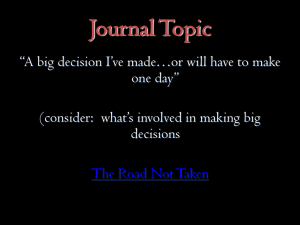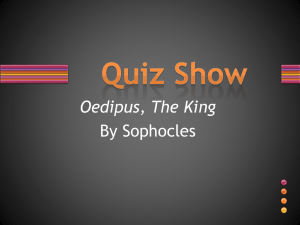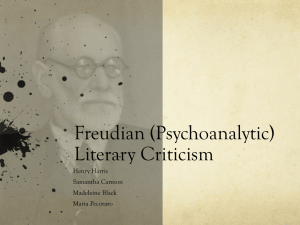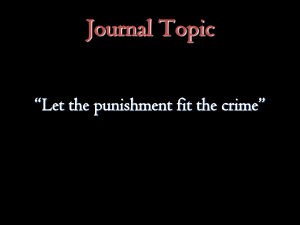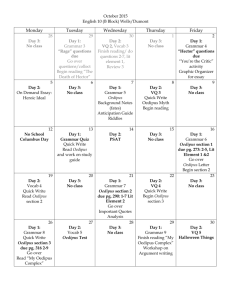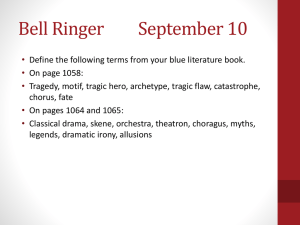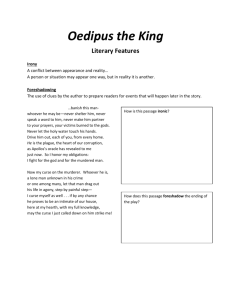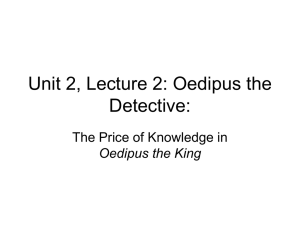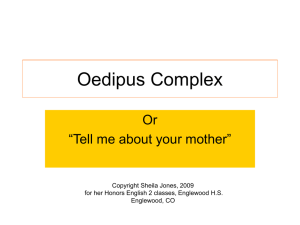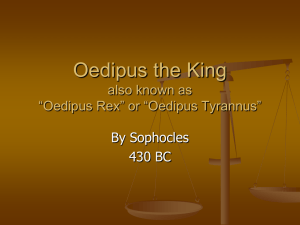Learning Sequence
advertisement
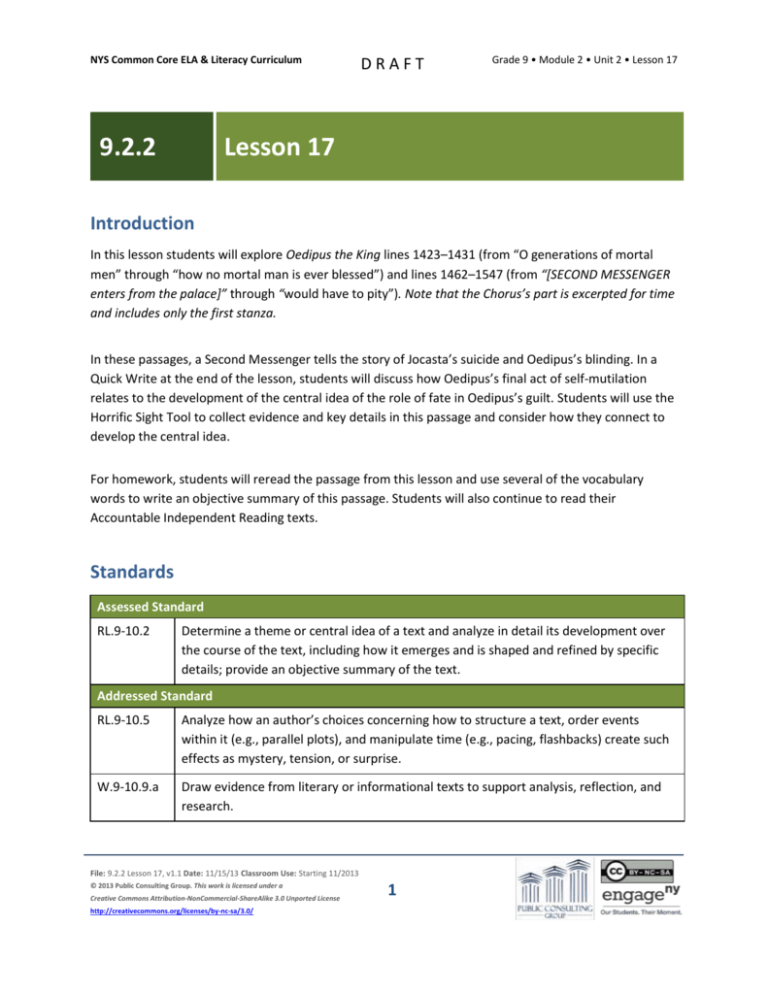
NYS Common Core ELA & Literacy Curriculum 9.2.2 DRAFT Grade 9 • Module 2 • Unit 2 • Lesson 17 Lesson 17 Introduction In this lesson students will explore Oedipus the King lines 1423–1431 (from “O generations of mortal men” through “how no mortal man is ever blessed”) and lines 1462–1547 (from “[SECOND MESSENGER enters from the palace]” through “would have to pity”). Note that the Chorus’s part is excerpted for time and includes only the first stanza. In these passages, a Second Messenger tells the story of Jocasta’s suicide and Oedipus’s blinding. In a Quick Write at the end of the lesson, students will discuss how Oedipus’s final act of self-mutilation relates to the development of the central idea of the role of fate in Oedipus’s guilt. Students will use the Horrific Sight Tool to collect evidence and key details in this passage and consider how they connect to develop the central idea. For homework, students will reread the passage from this lesson and use several of the vocabulary words to write an objective summary of this passage. Students will also continue to read their Accountable Independent Reading texts. Standards Assessed Standard RL.9-10.2 Determine a theme or central idea of a text and analyze in detail its development over the course of the text, including how it emerges and is shaped and refined by specific details; provide an objective summary of the text. Addressed Standard RL.9-10.5 Analyze how an author’s choices concerning how to structure a text, order events within it (e.g., parallel plots), and manipulate time (e.g., pacing, flashbacks) create such effects as mystery, tension, or surprise. W.9-10.9.a Draw evidence from literary or informational texts to support analysis, reflection, and research. File: 9.2.2 Lesson 17, v1.1 Date: 11/15/13 Classroom Use: Starting 11/2013 © 2013 Public Consulting Group. This work is licensed under a Creative Commons Attribution-NonCommercial-ShareAlike 3.0 Unported License http://creativecommons.org/licenses/by-nc-sa/3.0/ 1 NYS Common Core ELA & Literacy Curriculum DRAFT Grade 9 • Module 2 • Unit 2 • Lesson 17 a. Apply grades 9–10 Reading standards to literature (e.g., “Analyze how an author draws on and transforms source material in a specific work [e.g., how Shakespeare treats a theme or topic from Ovid or the Bible or how a later author draws on a play by Shakespeare]”). L.9-10.4.a Determine or clarify the meaning of unknown and multiple-meaning words and phrases based on grades 9–10 reading and content, choosing flexibly from a range of strategies. a. Use context (e.g., the overall meaning of a sentence, paragraph, or text; a word’s position or function in a sentence) as a clue to the meaning of a word or phrase. Assessment Assessment(s) The learning in this lesson will be captured through a Quick Write at the end of the lesson. Students will answer the following prompt based on the close reading (citing text evidence and analyzing key words and phrases) completed in the lesson. How does Oedipus’s reaction to Jocasta’s suicide shape a central idea in this passage? High Performance Response(s) A High Performance Response may include the following: Students’ responses should build upon the observations they made on their Horrific Sight Tool in order to explore how Oedipus’s decision to stab out his own eyes illuminates the connection that he makes between his investigation into the details of his own birth and Jocasta’s horrible death. Oedipus says that he “wished to know” things his eyes “did not see,” and that they have seen things that he wished they hadn’t. When he stabs his eyes out it suggests that he no longer feels a need to see or know anything because this seeing and knowing has only resulted in the death of Jocasta. Vocabulary Vocabulary to provide directly (will not include extended instruction) frantic (adj.) – desperate or wild with fear clenched (v.) – grasped firmly; held tightly File: 9.2.2 Lesson 17, v1.1 Date: 11/15/13 Classroom Use: Starting 11/2013 © 2013 Public Consulting Group. This work is licensed under a Creative Commons Attribution-NonCommercial-ShareAlike 3.0 Unported License http://creativecommons.org/licenses/by-nc-sa/3.0/ 2 NYS Common Core ELA & Literacy Curriculum DRAFT Grade 9 • Module 2 • Unit 2 • Lesson 17 corpse (n.) – a dead body conceive (v.) – to become pregnant immortal (adj.) – inhuman bolts (n.) – strong fastening rods sockets (n.) – hollow parts or pieces for holding or receiving something noose (n.) – a rope in a loop, usually associated with hanging a person brooches (n.) – pieces of jewelry that are held on clothing by a pin atrocious (adj.) – very evil or very bad hail (n.) – precipitation in the form of irregularly sized balls Cadmeians (n.) – citizens of Thebes cast (v.) – to throw Vocabulary to teach (may include direct word work and/or questions) wretched (adj.) – very unfortunate or unhappy Lesson Agenda/Overview Student-Facing Agenda % of Lesson Standards & Text Standards: RL.9-10.2, RL.9-10.5, W.9-10.9.a, L.9-10.4.a Text: Oedipus the King, lines 1423–1431 and 1462–1547 Learning Sequence 1. 2. 3. 4. 5. 6. Introduction to Lesson Agenda Homework Accountability Masterful Reading Lines 1423–1431 and 1462–1547 Reading and Horrific Sight Tool Quick Write Closing File: 9.2.2 Lesson 17, v1.1 Date: 11/15/13 Classroom Use: Starting 11/2013 © 2013 Public Consulting Group. This work is licensed under a Creative Commons Attribution-NonCommercial-ShareAlike 3.0 Unported License http://creativecommons.org/licenses/by-nc-sa/3.0/ 3 1. 2. 3. 4. 5. 6. 5% 10% 10% 55% 15% 5% NYS Common Core ELA & Literacy Curriculum DRAFT Grade 9 • Module 2 • Unit 2 • Lesson 17 Materials Copies of the Horrific Sight Tool for each student Student copies of the Short Response Checklist and Rubric (refer to 9.2.1 Lesson 1) Learning Sequence How to Use the Learning Sequence Symbol 10% Type of Text & Interpretation of the Symbol Percentage indicates the percentage of lesson time each activity should take. Plain text (no symbol) indicates teacher action. Bold text (no symbol) indicates questions for the teacher to ask students. Italicized text (no symbol) indicates a vocabulary word. Indicates student action(s). Indicates possible student response(s) to teacher questions. Indicates instructional notes for the teacher. Activity 1: Introduction to Lesson Agenda 5% Begin by introducing the agenda and sharing the assessed standard for this lesson: RL.9-10.2. Students will explore how Sophocles’s structural choices develop a central idea, as they read the Second Messenger’s account of Jocasta and Oedipus’s reactions to the news that Oedipus has in fact fulfilled the horrible prophesies about him. Students look at the agenda. Activity 2: Homework Accountability 10% Ask students to discuss in pairs how they revised and expanded their Mid-Unit Assessments using the Prophecy Evidence Collection Tool from Lesson 16. Student pairs discuss and share out about how they revised and expanded their Mid-Unit Assessments. File: 9.2.2 Lesson 17, v1.1 Date: 11/15/13 Classroom Use: Starting 11/2013 © 2013 Public Consulting Group. This work is licensed under a Creative Commons Attribution-NonCommercial-ShareAlike 3.0 Unported License http://creativecommons.org/licenses/by-nc-sa/3.0/ 4 NYS Common Core ELA & Literacy Curriculum DRAFT Grade 9 • Module 2 • Unit 2 • Lesson 17 Activity 3: Masterful Reading 10% Introduce the Quick Write assessment: (How does Oedipus’s reaction to Jocasta’s suicide shape a central idea in this passage?). Explain to students that this is the lesson assessment and the focus for today's reading. Display the Quick Write assessment for students to see. Students read the assessment and listen. Do a masterful reading of lines 1423–1431 (from “O generations of mortal men” through “how no mortal man is ever blessed”) and 1462–1547 (“[SECOND MESSENGER enters from the palace]” through the “would have to pity”). Note that the Chorus’s part is excerpted for time and includes only the first stanza. Students follow along, reading silently. Activity 4: Lines 1423–1431 and 1462–1547 Reading and Horrific Sight Tool 55% Instruct students to form pairs and read aloud lines 1423–1431 (the first stanza in the Chorus’s part) and lines 1462–1475 (from “[The Second Messenger enters from the palace]” through “know this—noble Jocasta, our queen, is dead”). Then direct pairs to discuss the following questions before sharing out with the class. What words and phrases in lines 1423–1431 help you to make meaning of the Chorus’s description of Oedipus as wretched? Students should identify the word poor, as well as call upon the Chorus’s reference to Laius, “O child of Laius,” and how this recalls the tragic turn of events to understand that wretched means someone who is very unfortunate or unhappy. Consider drawing students’ attention to their application of standard L.9-10.4.a through the process of determining word meaning through the use of context clues. Who is the Second Messenger speaking to? What message does he deliver? The Second Messenger is speaking to the “citizens of Thebes” (line 1463). Students may make the connection that these citizens are Sophocles’s Chorus. The Second Messenger says that Jocasta is dead: “Jocasta, our queen, is dead” (line 1475). File: 9.2.2 Lesson 17, v1.1 Date: 11/15/13 Classroom Use: Starting 11/2013 © 2013 Public Consulting Group. This work is licensed under a Creative Commons Attribution-NonCommercial-ShareAlike 3.0 Unported License http://creativecommons.org/licenses/by-nc-sa/3.0/ 5 NYS Common Core ELA & Literacy Curriculum DRAFT Grade 9 • Module 2 • Unit 2 • Lesson 17 Instruct student pairs to read aloud lines 1476–1493 (from “That poor unhappy lady!” through “How she died after that I don’t fully know”). Then direct pairs to discuss the following questions before sharing out with the class. What words and phrases in the Second Messenger’s description indicate Jocasta’s state of mind? Underline them in your text. Student annotations to indicate that Jocasta is very upset or hysterical should include some or all of the following: o o o o o o “frantic” “fingers...clenched” “ran through the hall” “slamming doors” “crying out” “moaning” Where does Jocasta run to? What significance might this place hold for her? Jocasta runs to her “marriage bed” (line 1483). Students might suggest that since Jocasta has just learned that she is married to her own son, the marriage bed represents the source of Jocasta’s pain, or the terrible realization that she has just had that her marriage with Laius produced the man who would one day kill Laius. Some students may extend this observation to include the idea that this “marriage bed” represents both Jocasta’s marriage to Oedipus and her marriage to Laius, in which she conceived Oedipus. Consider the following question as an extension: Given what you know about Jocasta’s past and the terrible prophecy, what might it mean for Jocasta to have “given birth twice over” (line 1491)? Students may connect this image to the fact that Oedipus has two relationships to Jocasta— her son and her husband. She had a child with her former husband Laius, and that son is now her husband: “husband from a husband” and also gave birth to Oedipus’s children: “children from a child” (line 1492). How does the Second Messenger describe the children of Oedipus and Jocasta? Where have you seen this description before? The Second Messenger describes the children as “cursed” (line 1489). Students may recall their reading from the previous lesson, in which Oedipus described himself as “cursed” three times (lines 1420–1422). File: 9.2.2 Lesson 17, v1.1 Date: 11/15/13 Classroom Use: Starting 11/2013 © 2013 Public Consulting Group. This work is licensed under a Creative Commons Attribution-NonCommercial-ShareAlike 3.0 Unported License http://creativecommons.org/licenses/by-nc-sa/3.0/ 6 NYS Common Core ELA & Literacy Curriculum DRAFT Grade 9 • Module 2 • Unit 2 • Lesson 17 How has the revelation of Oedipus’s true identity altered the lives of his family? The revelation of Oedipus’s identity has made it so that his children are seen as “cursed” by others and has driven his wife/mother crazy with grief. Instruct student pairs to read aloud lines 1494–1506 (from “With a scream Oedipus came bursting in” through “and burst into the room”). Then direct pairs to discuss the following questions before sharing out with the class. What does Oedipus do when he discovers Jocasta? Underline in your text. Students should identify the following actions from lines 1494–1506: o o o o o o o o o “with a scream” “bursting in” “charge around” “he kept asking us to give him a sword” “as he raved” “a dreadful howl” “leapt at the double doors” “bent the bolts by force out of the sockets” “burst into the room” What do these actions reveal about his state of mind? Oedipus is in a frantic, crazed state of mind; he seems dangerous and violent. What words and phrases can help you to make meaning of immortal in this context (line 1501)? According to the Second Messenger, what force is behind Oedipus’s actions? Students should identify the word “power” and the phrase “no human in the room came close to him” to understand that immortal means something that is not human. Some students may suggest that immortal means of the gods. The Second Messenger is suggesting that Oedipus’s actions are led by a power that is not human. Consider again drawing students’ attention to their application of standard L.9-10.4.a through the process of determining word meaning through the use of context clues. If students struggle to make meaning of immortal in context, provide the definition as something that is of the gods, having the quality of the gods. This may also be an opportunity to explain to students that the prefix im implies “not” or “opposite of” (impractical, impatient, imperfect). File: 9.2.2 Lesson 17, v1.1 Date: 11/15/13 Classroom Use: Starting 11/2013 © 2013 Public Consulting Group. This work is licensed under a Creative Commons Attribution-NonCommercial-ShareAlike 3.0 Unported License http://creativecommons.org/licenses/by-nc-sa/3.0/ 7 NYS Common Core ELA & Literacy Curriculum DRAFT Grade 9 • Module 2 • Unit 2 • Lesson 17 Instruct student pairs to continue to read aloud lines 1506–1512 (from “Then we saw her” through “what happened next was a horrific sight”). Then direct pairs to discuss the following question before sharing out with the class. What did Oedipus see? How does he respond to this sight? Oedipus saw Jocasta “hanging” from a rope; she had killed herself. Oedipus responds by taking Jocasta’s “body out of the noose” and “lying [her] on the ground.” Distribute the Horrific Sight Tool and read aloud the instructions: Read the passage in the left column. Then answer the questions in the right column. Instruct students to read from “from her clothes he ripped the golden brooches” through “So now and for all future time be dark” (lines 1513–1521). Students complete the Horrific Sight Tool in their groups. See the model Horrific Sight Tool. Instruct student pairs to read aloud lines 1522–1533 (from “With these words he raised his hand and struck” through “which men can name are theirs to keep”). Then direct pairs to discuss the following question before sharing out with the class. Who is the Second Messenger suggesting is responsible for this “disaster”? Who has paid the price? The Second Messenger is suggesting that Jocasta and Oedipus are both responsible because of their actions, “what these two have done,” and that they are both paying the price by being “swallow[ed] up a man and wife together” (lines 1527–1529). Instruct student pairs to read aloud lines 1534–1547 (from “And has that suffering man found some relief” through “would have to pity”). Then direct pairs to discuss the following question before sharing out with the class. What does Oedipus want “everyone” to see? According to the Second Messenger, how will the people react to this “horrific sight”? File: 9.2.2 Lesson 17, v1.1 Date: 11/15/13 Classroom Use: Starting 11/2013 © 2013 Public Consulting Group. This work is licensed under a Creative Commons Attribution-NonCommercial-ShareAlike 3.0 Unported License http://creativecommons.org/licenses/by-nc-sa/3.0/ 8 NYS Common Core ELA & Literacy Curriculum DRAFT Grade 9 • Module 2 • Unit 2 • Lesson 17 Oedipus wanted everyone to see the truth of who he is: “his father’s killer and his mother’s…” According to the Second Messenger, everyone will react with “pity” and “disgust” (lines 1546– 1547). Instruct students to return to the last passage (lines 1522-1533)and annotate the text for evidence of the continued development of a central idea (CI). Remind students that as they annotate for central idea, they are identifying textual evidence that may be used in the lesson assessment as well as the Endof-Unit Assessment, which address the development of central ideas in the text. This focused annotation supports students’ engagement with W.9-10.9.a, as they draw evidence from the text to use in their writing. Activity 5: Quick Write 15% Instruct students to respond briefly in writing to the following prompt: How does Oedipus’s reaction to Jocasta’s suicide shape a central idea in this passage? Remind students to use the Short Response Checklist and Rubric to guide their written responses. Display the prompt for students to see, or provide the prompt in hard copy. Students independently answer the prompt using evidence from the text. See the High Performance Response at the beginning of this lesson. Activity 6: Closing 5% Display and distribute the homework assignment. For homework students will reread the passages from this lesson (lines 1423–1431 and 1462–1547) and use several of the vocabulary words to write an objective summary of these passages. Also for homework, instruct students to continue their Accountable Independent Reading through the lens of their focus standard and prepare for a 3–5 minute discussion of their text based on that standard. Students follow along. File: 9.2.2 Lesson 17, v1.1 Date: 11/15/13 Classroom Use: Starting 11/2013 © 2013 Public Consulting Group. This work is licensed under a Creative Commons Attribution-NonCommercial-ShareAlike 3.0 Unported License http://creativecommons.org/licenses/by-nc-sa/3.0/ 9 NYS Common Core ELA & Literacy Curriculum DRAFT Grade 9 • Module 2 • Unit 2 • Lesson 17 Homework Reread the passages from this lesson (lines 1423–1431 and 1462–1547) and use several of the vocabulary words to write an objective summary of this passage. Continue to read your Accountable Independent Reading text through the lens of a focus standard of your choice and prepare for a 3–5 minute discussion of your text based on that standard. File: 9.2.2 Lesson 17, v1.1 Date: 11/15/13 Classroom Use: Starting 11/2013 © 2013 Public Consulting Group. This work is licensed under a Creative Commons Attribution-NonCommercial-ShareAlike 3.0 Unported License http://creativecommons.org/licenses/by-nc-sa/3.0/ 10 NYS Common Core ELA & Literacy Curriculum DRAFT Grade 9 • Module 2 • Unit 2 • Lesson 17 Horrific Sight Tool Name: Class: Date: Instructions Read the passage in the left column. Then answer the questions in the right column. “from her clothes he ripped the golden brooches she wore as ornaments, raised them high, and drove them deep into his eyeballs, crying as he did so: ‘You will no longer see all those atrocious things I suffered, the dreadful things I did! No. You have seen those you never should have looked upon, and those I wished to know you did not see. So now and for all future time be dark!’" (lines 1513–1521) 1. What does Oedipus do in response to the sight of Jocasta? 2. Who is the “you” that Oedipus is referring to? Who is the “I”? brooches (n.) – pieces of jewelry that are held on clothing by a pin atrocious (adj.) – very evil or very bad 3. What relationship is Oedipus constructing between “you” and “I”? 4. What relationship is Oedipus constructing between “see[ing]” and “know[ing]”? File: 9.2.2 Lesson 17, v1.1 Date: 11/15/13 Classroom Use: Starting 11/2013 © 2013 Public Consulting Group. This work is licensed under a Creative Commons Attribution-NonCommercial-ShareAlike 3.0 Unported License http://creativecommons.org/licenses/by-nc-sa/3.0/ 11 NYS Common Core ELA & Literacy Curriculum DRAFT Grade 9 • Module 2 • Unit 2 • Lesson 17 Model Horrific Sight Tool Name: Class: Date: Instructions Read the passage in the left column. Then answer the questions in the right column. “from her clothes he ripped the golden brooches she wore as ornaments, raised them high, and drove them deep into his eyeballs, crying as he did so: ‘You will no longer see all those atrocious things I suffered, the dreadful things I did! No. You have seen those you never should have looked upon, and those I wished to know you did not see. So now and for all future time be dark!’" (lines 1513–1521) brooches (n.) – pieces of jewelry that are held on clothing by a pin atrocious (adj.) – very evil or very bad 1. What does Oedipus do in response to the sight of Jocasta? Oedipus takes Jocasta’s “golden brooches” and jabs out his eyeballs. 2. Who is the “you” that Oedipus is referring to? Who is the “I”? Students should identify that the “you” Oedipus is referring to are his eyes, and the “I” is himself. 3. What relationship is Oedipus constructing between “you” and “I”? Oedipus is establishing a difference between himself and his eyes. He is speaking to his eyes like they are a different person. His eyes betrayed him by seeing things they should not have seen (“you have seen those you never should have looked upon”) and not seeing things they should have seen (“those I wished to know you did not see”). Now that he has poked them out, Oedipus believes his eyes won’t be able to see the things he did anymore. 4. What relationship is Oedipus constructing between “see[ing]” and “know[ing]”? Oedipus says that things he “wished to know you [his eyes] did not see.” Oedipus is saying that to know something he would need to see it, but since his eyes didn’t see the right things Oedipus does not have the right knowledge. File: 9.2.2 Lesson 17, v1.1 Date: 11/15/13 Classroom Use: Starting 11/2013 © 2013 Public Consulting Group. This work is licensed under a Creative Commons Attribution-NonCommercial-ShareAlike 3.0 Unported License http://creativecommons.org/licenses/by-nc-sa/3.0/ 12
